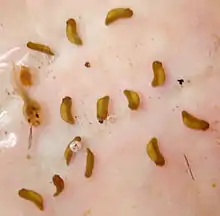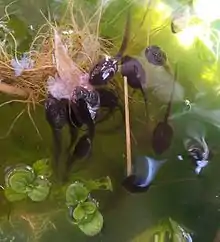蝌蚪
蝌蚪,古時寫作科斗,是两栖动物蛙、蟾蜍、蝾螈或蚓螈的幼體,生長在水裡。在此階段,蝌蚪透過鰓来呼吸。起初牠們没有四肢,而是有一條鰭狀般的尾巴,因此牠們能像大多數魚類般通过摆动尾巴来游水。成年后它們開始蜕变,漸漸長出四肢,然后通过細胞凋亡来摆脱尾巴。蝌蚪既有草食的也有雜食的。

大蟾蜍的生長
描述

虎皮蛙的胚胎和一條蝌蚪。

正在吃鮭魚肉的大蟾蜍蝌蚪
蝌蚪一般生活在水中,但也有少數蝌蚪,例如Indirana beddomii和Thoropa miliaris的是半陸生的,而Indirana semipalmata的更是完全陸生[2]。蝌蚪的大小也不一定,不同的種之間差異極大。即使同科也有相當不同,例如角蟾科的蝌蚪在晚期長度在33~106(1.3~4.2英寸)之間。奇异多指节蟾的蝌蚪為世界最大的蛙類蝌蚪,長度可達25(9.8英寸)[3]。
化石記錄
儘管蝌蚪的身體柔軟不易保存,仍然有發現上中新世的蝌蚪化石,其長度達10(3.9英寸)[4] 它們以生物膜的形態保存了下來,并留有硬質的下顎和骨頭[5]。西班牙利夫羅斯發現的蝌蚪化石還保存有碳酸鈣形式的腦殼、磷酸鈣的神經索,腸子里還有岩石碎屑[4]。
與人類的關係
参考文献
- . 國家地理雜誌中文網. [2019-03-19].
- Zug, G. R.; Vitt, L. J.; Caldwell, J. P. . Academic Press. 2001: 430. ISBN 978-0-12-782622-6.
- Crump, Martha L. (PDF). Amphibian Ecology and Conservation. A Handbook of Techniques. 2009: 3–19. (原始内容 (PDF)存档于2011-07-15).
- McNamara, M. E.; Orr, P. J.; Kearns, S. L.; Alcalá, L.; Anadón, P.; Peñalver-Mollá, E. . Lethaia. 2009, 43 (3): 290–306. doi:10.1111/j.1502-3931.2009.00192.x.
- McNamara, M. E.; Orr, P. J.; Kearns, S. L.; Alcalá, L.; Anadón, P.; Peñalver-Mollá, E. (PDF). The Palaeontological Association 50th Annual Meeting. The Palaeontological Association. 2006. (原始内容 (PDF)存档于2011-07-27).
- Li, Cheng; Xian-Guang Guo, Yue-Zhao Wang. . Current Zoology. 2011, 57 (1): 93–100.
- Fei Liang, Wu Guanfu. . IUCN Red List of Threatened Species. 2004. [22 October 2013].
- Biju, S.D.; Dutta, Sushil and Inger, Robert. . IUCN Red List of Threatened Species. 2004. [4 May 2014].
- Javier Icochea, Edgar Lehr. . IUCN Red List of Threatened Species. 2004. [23 October 2013].
- 李, 子賢. . 云南师范大学学报:哲学社会科学版. 2010, (6): 67–76.
- Scott, James George, Sir. 1935. The Wa or Lawa: Head-Hunters. In Burma and Beyond. p. 292
- . 鳳凰網. [2014-06-04].
This article is issued from Wikipedia. The text is licensed under Creative Commons - Attribution - Sharealike. Additional terms may apply for the media files.
